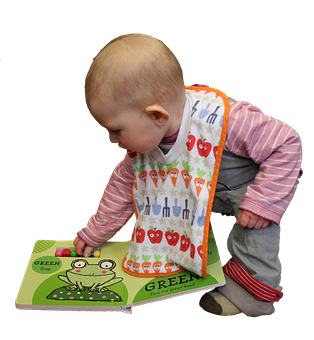
Your Baby Can't Read--And That's a Good Thing
Erin Burt
 In 1996, a product began to show up on infomercials claiming that it could teach babies “early literacy skills” and have them reading by age one. Eager new parents jumped on this idea of getting a head start on reading proficiency and “Your Baby Can Read” became a multi-million-dollar business.
In 1996, a product began to show up on infomercials claiming that it could teach babies “early literacy skills” and have them reading by age one. Eager new parents jumped on this idea of getting a head start on reading proficiency and “Your Baby Can Read” became a multi-million-dollar business.
There’s just one problem. Babies aren’t supposed to read.
In fact, teaching babies to read the way you teach a preschooler or older child to read could actually cause problems and inhibit their natural learning sequence as it is understood in pediatric developmental psychology.
All this may seem like a moot point since the company officially announced that it was bankrupt and was ceasing operations due to costs of litigation in 2012. Since then, the franchise has been widely criticized and their claims openly debunked by leading experts at the American Academy of Pediatrics, The Campaign for Commercial Free Childhood, and other leading developmental psychologists across the globe. The company quietly re-opened their doors in recent years with a new name and a slightly tweaked product, but it’s basically the same thing as the first one, with more acceptable wording.
Be that as it may, inquiring moms do want to know about what we can do to best promote early literacy and ensure that our children have the foundation for learning that they need to thrive. To do that we have to understand how babies learn.
Literacy skills are not acquired through early repetition of words and concepts. That’s just not how the human baby brain learns. It can be forced to learn this, but in the process, it may be bypassing or under-developing some of the key foundational processes it is supposed to acquire before it learns to “read.” It is these foundational principles that will allow the brain to develop the pathways necessary for reading later. Things like gross motor skills and lateral movement, language acquisition through immersion, and child-initiated problem solving are all things a child needs to learn first and learns best at home or in familiar environments. As children go naturally about their day, speaking to and being spoken to by loving caregivers, exploring the environment and being allowed to develop at their own pace, they thrive. In fact, being in this loving and slow-paced environment is where a child’s brain can best ready itself for later learning.
Secure Attachment
I’m going to camp here for a few paragraphs because this one little thing is basically the single most important thing a child needs to learn in the first five years of his or her little life. If a child is not able to form secure attachments with the adults and peers in his world, he will struggle in every area of his life to move forward and acquire learning, emotional intelligence, and coping skills.
How does a child form secure attachments? Secure attachment begins to occur in early infancy as the baby learns that his cries will be heard, and that his true needs will be quickly met. In this way, he feels secure and safe and his brain is able to begin understanding that people can be trusted. In this safe mental and emotional atmosphere, learning and creativity begin to thrive during toddler and pre-school years because his brain isn’t being occupied by anxious, wondering, and fearful thoughts about his immediate environment. By having his needs met early and often in his young life, a child grows confident, independent, and sees the world as a place where he will be able to articulate his needs and have them met. A securely attached child feels safe in his world and has the attention and loving care of mature, affectionate, and responsible adults, and so he naturally grows confident and independent, enjoying freedom to explore learning and creative concepts, like reading.
What does this look like in everyday life?
The most important thing you need to be doing with your sweet little baby for the first few years is to just be present and loving with him. Speaking kindly to him, attending to his needs, responding to his different cues and cries, setting age appropriate limits and lovingly enforcing them are the best ways to foster strong pathways to a whole and healthy child who is able to thrive and learn appropriately. Allowing the baby to lead and find a natural rhythm to his day that best works for his unique makeup is also facilitating the best possible atmosphere for growth.
Please don’t misunderstand me to say that reading and early exposure to books is unimportant! Reading to your baby and toddler is critically important for acquiring later reading skills, and it is when children read with parents that they begin to develop empathy as they learn and observe the feelings and stories of the characters in books.
Here’s what you don’t need to do:
- Try to teach them their ABC’s by some random deadline
- Quiz them
- Ask them to sound out words
- Have them do learning books (unless they directly show interest and ask for them)
Instead…
Just reading to and talking to your baby, pointing out and naming things, people, and feelings readies them to acquire strong literacy skills. The evidence for focusing on play, affection, and feelings in the early years is so strong that in recent years overly academic pre-schools have come under significant fire for pushing academic concepts on little brains who are not ready to acquire and retain them.
So, you can relax and keep doing all the things you do in the natural course of your day mama, because your baby is learning the concepts he needs to be able to read someday as he furrows his brow and figures out how to get around that baby gate. He’s priming his brain for literacy one block tower, snuggle, song, and story at a time.
Your baby can’t read, and that’s exactly as it should be.
Lauren resides in Oklahoma with her husband and two children. She is a birth worker and an aspiring writer. In her spare time, she loves to work out and spend time perusing old and new bookstores.







